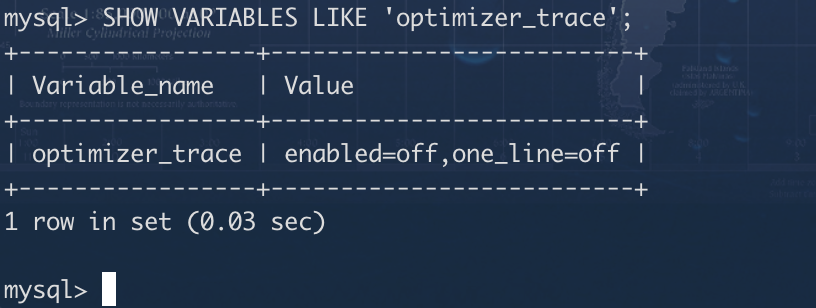17_OPTIMIZER-TRACE
一镜到底 #
对于 MySQL 5.6 以及之前的版本来说,查询优化器就像是一个黑盒子一样,你只能通过 EXPLAIN 语句查看到最后优化器决定使用的执行计划,却无法知道它为什么做这个决策。这对于一部分喜欢刨根问底的小伙伴来说简直是灾难:“我就觉得使用其他的执行方案比 EXPLAIN 输出的这种方案强,凭什么优化器做的决定和我想的不一样呢?”
在 MySQL 5.6 以及之后的版本中,设计 MySQL 的大叔贴心的为这部分小伙伴提出了一个 optimizer trace 的功能,这个功能可以让我们方便的查看优化器生成执行计划的整个过程,这个功能的开启与关闭由 系统变量 optimizer_trace 决定,我们看一下:
SHOW VARIABLES LIKE 'optimizer_trace';
可以看到 enabled 值为 off ,表明这个功能默认是关闭的。
小贴士
one_line 的值是控制输出格式的,如果为 on 那么所有输出都将在一行中展示,不适合人阅读,所以我们就保持其默认值为 off 吧。
如果想打开这个功能,必须首先把 enabled 的值改为 on ,就像这样:
SET optimizer_trace="enabled=on";然后我们就可以输入我们想要查看优化过程的查询语句,当该查询语句执行完成后,就可以到 information_schema 数据库下的 OPTIMIZER_TRACE 表 中查看完整的优化过程。这个 OPTIMIZER_TRACE 表有4个列,分别是:
- QUERY :表示我们的查询语句。
- TRACE :表示优化过程的JSON格式文本。
- MISSING_BYTES_BEYOND_MAX_MEM_SIZE :由于优化过程可能会输出很多,如果超过某个限制时,多余的文本将不会被显示,这个字段展示了被忽略的文本字节数
- INSUFFICIENT_PRIVILEGES :表示是否没有权限查看优化过程,默认值是0,只有某些特殊情况下才会是 1 ,我们暂时不关心这个字段的值。
完整的使用 optimizer trace 功能的步骤总结如下:
# 1. 打开optimizer trace功能 (默认情况下它是关闭的): SET optimizer_trace="enabled=on"; # 2. 这里输入你自己的查询语句 SELECT ...; # 3. 从OPTIMIZER_TRACE表中查看上一个查询的优化过程 SELECT * FROM information_schema.OPTIMIZER_TRACE; # 4. 可能你还要观察其他语句执行的优化过程,重复上边的第2、3步 ... # 5. 当你停止查看语句的优化过程时,把optimizer trace功能关闭 SET optimizer_trace="enabled=off";现在我们有一个搜索条件比较多的查询语句,它的执行计划如下:
EXPLAIN SELECT * FROM s1 WHERE key1 > 'z' AND key2 < 1000000 AND key3 IN ('a', 'b', 'c') AND common_field = 'abc'; # placeholder
可以看到该查询可能使用到的索引有3个,那么为什么优化器最终选择了 idx_key2 而不选择其他的索引或者直接全表扫描呢?这时候就可以通过 otpimzer trace 功能来查看优化器的具体工作过程:
SET optimizer_trace="enabled=on"; SELECT * FROM s1 WHERE key1 > 'z' AND key2 < 1000000 AND key3 IN ('a', 'b', 'c') AND common_field = 'abc'; SELECT * FROM information_schema.OPTIMIZER_TRACE\G我们直接看一下通过查询 OPTIMIZER_TRACE 表得到的输出(我使用 # 后跟随注释的形式为大家解释了优化过程中的一些比较重要的点,大家重点关注一下):
mysql> SELECT * FROM information_schema.OPTIMIZER_TRACE\G *************************** 1. row *************************** QUERY: SELECT * FROM s1 WHERE key1 > 'z' AND key2 < 1000000 AND key3 IN ('a', 'b', 'c') AND common_field = 'abc' # 分析的查询语句是什么 TRACE: { # 优化的具体过程 "steps": [ { "join_preparation": { # prepare阶段 "select#": 1, "steps": [ { "IN_uses_bisection": true }, { "expanded_query": "/* select#1 */ select `s1`.`id` AS `id`,`s1`.`key1` AS `key1`,`s1`.`key2` AS `key2`,`s1`.`key3` AS `key3`,`s1`.`key_part1` AS `key_part1`,`s1`.`key_part2` AS `key_part2`,`s1`.`key_part3` AS `key_part3`,`s1`.`common_field` AS `common_field` from `s1` where ((`s1`.`key1` > 'z') and (`s1`.`key2` < 1000000) and (`s1`.`key3` in ('a','b','c')) and (`s1`.`common_field` = 'abc'))" } ] } }, { "join_optimization": { # optimize阶段 "select#": 1, "steps": [ { "condition_processing": { # 处理搜索条件 "condition": "WHERE", # 原始搜索条件 "original_condition": "((`s1`.`key1` > 'z') and (`s1`.`key2` < 1000000) and (`s1`.`key3` in ('a','b','c')) and (`s1`.`common_field` = 'abc'))", "steps": [ { "transformation": "equality_propagation", # 等值传递转换 "resulting_condition": "((`s1`.`key1` > 'z') and (`s1`.`key2` < 1000000) and (`s1`.`key3` in ('a','b','c')) and (`s1`.`common_field` = 'abc'))" }, { "transformation": "constant_propagation", # 常量传递转换 "resulting_condition": "((`s1`.`key1` > 'z') and (`s1`.`key2` < 1000000) and (`s1`.`key3` in ('a','b','c')) and (`s1`.`common_field` = 'abc'))" }, { "transformation": "trivial_condition_removal", # 去除没用的条件 "resulting_condition": "((`s1`.`key1` > 'z') and (`s1`.`key2` < 1000000) and (`s1`.`key3` in ('a','b','c')) and (`s1`.`common_field` = 'abc'))" } ] } }, { "substitute_generated_columns": { # 替换虚拟生成列 } }, { "table_dependencies": [ # 表的依赖信息 { "table": "`s1`", "row_may_be_null": false, "map_bit": 0, "depends_on_map_bits": [ ] } ] }, { "ref_optimizer_key_uses": [ ] }, { "rows_estimation": [ # 预估不同单表访问方法的访问成本 { "table": "`s1`", "range_analysis": { "table_scan": { # 全表扫描的行数以及成本 "rows": 10039, "cost": 2106.9 }, "potential_range_indexes": [ # 分析可能使用的索引 { "index": "PRIMARY", # 主键不可用 "usable": false, "cause": "not_applicable" }, { "index": "idx_key2", # idx_key2 可能被使用 "usable": true, "key_parts": [ "key2" ] }, { "index": "idx_key1", # idx_key1 可能被使用 "usable": true, "key_parts": [ "key1", "id" ] }, { "index": "idx_key3", # idx_key3 可能被使用 "usable": true, "key_parts": [ "key3", "id" ] }, { "index": "idx_key_part", # idx_keypart 不可用 "usable": false, "cause": "not_applicable" } ], "setup_range_conditions": [ ], "group_index_range": { "chosen": false, "cause": "not_group_by_or_distinct" }, "analyzing_range_alternatives": { # 分析各种可能使用的索引的成本 "range_scan_alternatives": [ { "index": "idx_key2", # 使用 idx_key2 的成本分析 "ranges": [ # 使用 idx_key2 的范围区间 "NULL < key2 < 1000000" ], "index_dives_for_eq_ranges": true, # 是否使用 index dive "rowid_ordered": false, # 使用该索引获取的记录是否按照主键排序 "using_mrr": false, # 是否使用 mrr "index_only": false, # 是否是索引覆盖访问 "rows": 10000, # 使用该索引获取的记录条数 "cost": 12001, # 使用该索引的成本 "chosen": false, # 是否选择该索引 "cause": "cost" # 因为成本太大所以不选择该索引 }, { "index": "idx_key1", "ranges": [ "z < key1" ], "index_dives_for_eq_ranges": true, "rowid_ordered": false, "using_mrr": false, "index_only": false, "rows": 1, "cost": 2.21, "chosen": true }, { "index": "idx_key3", "ranges": [ "a <= key3 <= a", "b <= key3 <= b", "c <= key3 <= c" ], "index_dives_for_eq_ranges": true, "rowid_ordered": false, "using_mrr": false, "index_only": false, "rows": 3, "cost": 6.61, "chosen": false, "cause": "cost" } ], "analyzing_roworder_intersect": { # 分析使用索引合并的成本 "usable": false, "cause": "too_few_roworder_scans" } }, "chosen_range_access_summary": { # 对于上述单表查询 s1 最优的访问方法 "range_access_plan": { "type": "range_scan", "index": "idx_key1", "rows": 1, "ranges": [ "z < key1" ] }, "rows_for_plan": 1, "cost_for_plan": 2.21, "chosen": true } } } ] }, { "considered_execution_plans": [ # 分析各种可能的执行计划 #(对多表查询这可能有很多种不同的方案,单表查询的方案上边已经分析过了,直接选取 idx_key1 就好) { "plan_prefix": [ ], "table": "`s1`", "best_access_path": { "considered_access_paths": [ { "rows_to_scan": 1, "access_type": "range", "range_details": { "used_index": "idx_key1" }, "resulting_rows": 1, "cost": 2.41, "chosen": true } ] }, "condition_filtering_pct": 100, "rows_for_plan": 1, "cost_for_plan": 2.41, "chosen": true } ] }, { "attaching_conditions_to_tables": { # 尝试给查询添加一些其他的查询条件 "original_condition": "((`s1`.`key1` > 'z') and (`s1`.`key2` < 1000000) and (`s1`.`key3` in ('a','b','c')) and (`s1`.`common_field` = 'abc'))", "attached_conditions_computation": [ ], "attached_conditions_summary": [ { "table": "`s1`", "attached": "((`s1`.`key1` > 'z') and (`s1`.`key2` < 1000000) and (`s1`.`key3` in ('a','b','c')) and (`s1`.`common_field` = 'abc'))" } ] } }, { "refine_plan": [ # 再稍稍的改进一下执行计划 { "table": "`s1`", "pushed_index_condition": "(`s1`.`key1` > 'z')", "table_condition_attached": "((`s1`.`key2` < 1000000) and (`s1`.`key3` in ('a','b','c')) and (`s1`.`common_field` = 'abc'))" } ] } ] } }, { "join_execution": { # execute 阶段 "select#": 1, "steps": [ ] } } ] } MISSING_BYTES_BEYOND_MAX_MEM_SIZE: 0 # 因优化过程文本太多而丢弃的文本字节大小,值为 0 时表示并没有丢弃 INSUFFICIENT_PRIVILEGES: 0 # 权限字段 1 row in set (0.01 sec) mysql>大家看到这个输出的第一感觉就是这文本也太多了点儿吧,其实这只是优化器执行过程中的一小部分,设计 MySQL 的大叔可能会在之后的版本中添加更多的优化过程信息。不过杂乱之中其实还是蛮有规律的,优化过程大致分为了三个阶段:
- prepare 阶段
- optimize 阶段
- execute 阶段
我们所说的基于成本的优化主要集中在 optimize 阶段,对于单表查询来说,我们主要关注 optimize 阶段的 “rows_estimation” 这个过程,这个过程深入分析了对单表查询的各种执行方案的成本;对于多表连接查询来说,我们更多需要关注 “considered_execution_plans” 这个过程,这个过程里会写明各种不同的连接方式所对应的成本。反正优化器最终会选择成本最低的那种方案来作为最终的执行计划,也就是我们使用 EXPLAIN 语句所展现出的那种方案。
如果有小伙伴对使用 EXPLAIN 语句展示出的对某个查询的执行计划很不理解,大家可以尝试使用 optimizer trace 功能来详细了解每一种执行方案对应的成本,相信这个功能能让大家更深入的了解 MySQL 查询优化器。